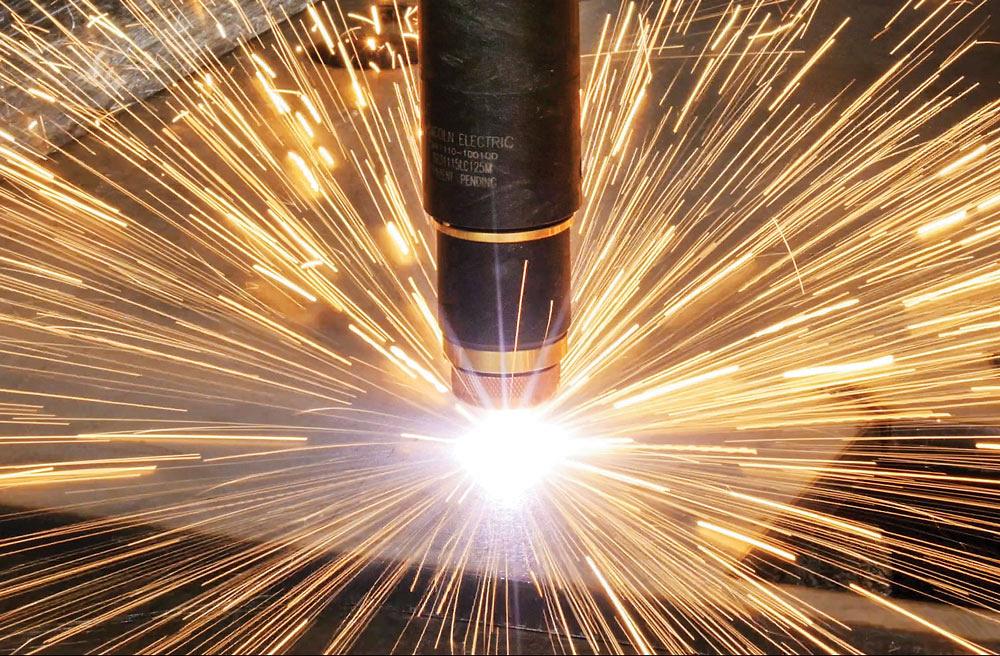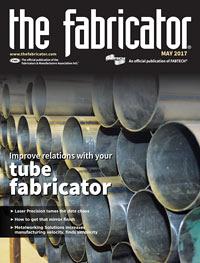Editor-in-Chief
- FMA
- The Fabricator
- FABTECH
- Canadian Metalworking
Categories
- Additive Manufacturing
- Aluminum Welding
- Arc Welding
- Assembly and Joining
- Automation and Robotics
- Bending and Forming
- Consumables
- Cutting and Weld Prep
- Electric Vehicles
- En Español
- Finishing
- Hydroforming
- Laser Cutting
- Laser Welding
- Machining
- Manufacturing Software
- Materials Handling
- Metals/Materials
- Oxyfuel Cutting
- Plasma Cutting
- Power Tools
- Punching and Other Holemaking
- Roll Forming
- Safety
- Sawing
- Shearing
- Shop Management
- Testing and Measuring
- Tube and Pipe Fabrication
- Tube and Pipe Production
- Waterjet Cutting
Industry Directory
Webcasts
Podcasts
FAB 40
Advertise
Subscribe
Account Login
Search
A tip sheet for quality plasma-cut edges
The mechanized plasma cutting table has to be running right to deliver quality parts
- By Dan Davis
- April 28, 2017
- Article
- Plasma Cutting

Figure 1
Typically, if the cutting guidelines for certain materials and thicknesses are followed, a plasma cutting operator should get acceptable quality, such as with this initial piercing of 0.25-in. plate.
Plasma cutting still holds an important place in the metal fabricating landscape. It produces a high-quality cut on plate, without the significantly larger investment requirement associated with laser cutting machines, and it is the go-to choice for beveling large weldments.
Technology has progressed over the years to help produce squarer edges and cleaner surface areas during cutting, but those modern advancements aren’t always found on cutting tables. Sometimes a plasma cutting table operator is making do with what’s available until that justification can be made for an investment in new plasma cutting technology.
That’s where an experienced plasma cutting table operator can make the difference. The FABRICATOR spoke with Chris Williams, The Lincoln Electric Co. director of motion controls, plasma torches, and cutting tables, to find out just what these experienced operators look for to keep quality parts coming off the plasma cutting table and how plasma technology has evolved to take a lot of the guesswork out of cutting.
Maintain a Constant Speed
It’s a sight that almost any metal fabricator who has been around a plasma cutting table is familiar with: plate with ripples on the edges and heavy dross on the bottom of the plate. There’s a simple explanation for this.
“You are effectively dragging the arc, which means the arc is not straight,” Williams said. “The arc is elliptical, and it’s also bent while being dragged around the table.”
An experienced operator has the visual cue, obviously, but there is an audible cue as well. The operator is looking for the machine to be running at a speed that generates a consistent pitch, with no real fluctuations in frequency. Williams equates it to a milling machine that is running smoothly and generating a consistently high frequency. If major pitch changes occur during the cutting process, be it milling or plasma cutting, an experienced operator should be able to alter cutting parameters.
To get an idea of how modern motion control has changed the way mechanized plasma cutting tables work, Williams explained just how a corner is maintained without a formal stopping of the plasma torch.
“As one axis is decelerating as you come into a corner, the other axis starts to accelerate. That generates a sinusoidal profile that creates a curve on the corner,” he said. “This allows the plasma to roll around the corner. That limits the amount of dross and the loss of the corner. It stops the gas from blowing out as much corner material as might happen if the torch had to stop when making the corner.”
Again, Williams referenced milling, where metalworkers are used to seeing a cutting tool roll around a corner. In both instances, cutting is continuous, and the integrity of the corner is maintained.
Find the Correct Flame Height
The goal of most 2-D plasma cutting operations is to produce a flat and smooth edge surface. If too much material is removed from the top or bottom of the cut edge, the fabricator has an unintentional bevel, which isn’t likely what the customer expects.

Figure 2
By the looks of the edges, the consumables in the plasma torch still appear to be in good shape.
This is why the right torch-to-work distance needs to be set. The flame’s elliptical shape means that the torch has to align the flame’s midsection with the plate edge for the straight cut. If the torch is too low, more material is removed from the bottom of the cut than the top. If the torch is too high, more material is removed from the bottom of the cut.
“You’ll also see dross that is going to be generated on the bottom and the top of the plate, for that matter. It’ll need to be knocked off, and that typically means a secondary process,” Williams said.
He added that the cut charts that come with mechanized plasma cutting tables give the operator an idea of how to set that torch-to-work distance, as well as other parameters such as initial pierce height, arc voltage, and cutting speed (see Figure 1). Testing is done to fine-tune these production settings, and typically they should work when put to use.
The motion control also works to keep a constant arc length to position the flame optimally to deliver the best cut quality.
Stay on Top of Consumable Wear
Plenty of metal fabricators run plasma cutting torches until the consumables absolutely can’t deliver an accurate cut no matter what parameters they alter. In short, the cut quality can be described as horrific.
This is where an operator isn’t paying attention. When the electrode starts to go, the operator should be able to tell that some of the definition of the cut is being lost simultaneously (see Figure 2).
“The geometric accuracy, such as the cylindricity of circles, will be off,” Williams said. “If you measure the parts, you’ll find that they are no longer accurate and that they definitely are not as repeatable.”
Again, modern control technology helps an operator stay on top of the condition of consumables with constant arc voltage monitoring. As the electrode wears, the arc voltage fluctuates during cutting. If the operator can notice these changes during cutting, the electrode and possibly other consumable items can be checked and replaced, if needed, to avoid rejected parts.
Double-check the Table’s Performance
Not all plasma cutting tables are created equal, and not all equipment performs at originally specified levels with the passage of time. Therefore, an operator needs to be vigilant in making sure that the table is performing as expected.
This literally might call for a time test to find out if the table is cutting at specified speeds. If the table’s speed is lagging, someone needs to call maintenance or the OEM to fine-tune the machine.
Williams said that fabricators with newer mechanized tables with servomotor systems don’t have to worry about tune-ups because the motors can adjust for any changes in inertia, friction, or environment. The modern control technology allows the torch to adapt to a given situation and make changes, such as adjusting torque, to maintain predetermined cutting parameters. Older motion control systems typically rely on stepper motors and proportional integral derivative controllers that can deliver only what was programmed, which doesn’t allow them to adjust to changing conditions. That’s when fine-tuning is necessary, he said.
Plasma Technology Continues to Improve
While having a skilled operator is always preferable to having a less experienced individual running a mechanized plasma cutting table, sometimes that just isn’t possible. As more experienced fabricators leave the workforce, fabricating companies are looking to new technology to ease the transition of new workers entering the manufacturing field.
“High-definition plasma has certainly come a long way, and it will continue to improve,” Williams said. “We are just now getting to the point where we are controlling the arc in a much more complete way. We also are understanding how to use different gases to achieve different cut quality.”
One example is the use of air instead of other gases during plasma cutting and still achieving acceptable edge quality. That can be an enormous benefit for metal fabricators as the cost to use air is significantly less than using another gas such as oxygen.
That leads to one more tip for mechanized plasma table operators of all experience levels: Keep an eye on new technology advancements because they can make a big difference in productivity and quality of cut parts.
The Lincoln Electric Co., 216-481-8100, www.lincolnelectric.com
About the Author

Dan Davis
2135 Point Blvd.
Elgin, IL 60123
815-227-8281
Dan Davis is editor-in-chief of The Fabricator, the industry's most widely circulated metal fabricating magazine, and its sister publications, The Tube & Pipe Journal and The Welder. He has been with the publications since April 2002.
subscribe now

The Fabricator is North America's leading magazine for the metal forming and fabricating industry. The magazine delivers the news, technical articles, and case histories that enable fabricators to do their jobs more efficiently. The Fabricator has served the industry since 1970.
start your free subscription- Stay connected from anywhere

Easily access valuable industry resources now with full access to the digital edition of The Fabricator.

Easily access valuable industry resources now with full access to the digital edition of The Welder.

Easily access valuable industry resources now with full access to the digital edition of The Tube and Pipe Journal.
- Podcasting
- Podcast:
- The Fabricator Podcast
- Published:
- 04/16/2024
- Running Time:
- 63:29
In this episode of The Fabricator Podcast, Caleb Chamberlain, co-founder and CEO of OSH Cut, discusses his company’s...
- Trending Articles
Tips for creating sheet metal tubes with perforations

Are two heads better than one in fiber laser cutting?

Supporting the metal fabricating industry through FMA

JM Steel triples capacity for solar energy projects at Pennsylvania facility

Omco Solar opens second Alabama manufacturing facility

- Industry Events
16th Annual Safety Conference
- April 30 - May 1, 2024
- Elgin,
Pipe and Tube Conference
- May 21 - 22, 2024
- Omaha, NE
World-Class Roll Forming Workshop
- June 5 - 6, 2024
- Louisville, KY
Advanced Laser Application Workshop
- June 25 - 27, 2024
- Novi, MI


























